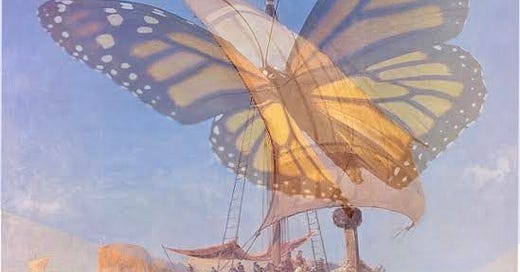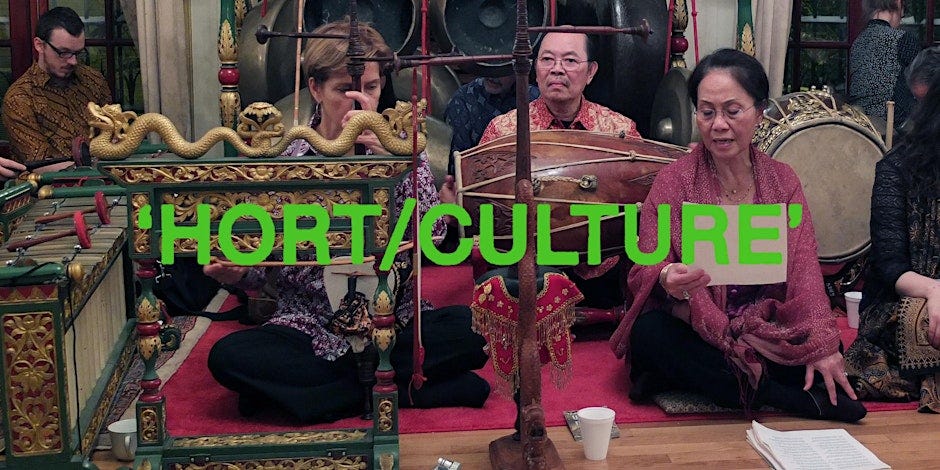Socrates
Then it is not correct to say, as people do, that those who want nothing are happy.Callicles
No, for at that rate stones and corpses would be extremely happy.Socrates
Well, well, as you say, life is strange. For I tell you I should not wonder if Euripides’ words were true, when he says: ‘Who knows if to live is to be dead, and to be dead, to live?’ and we really, it may be, are dead; in fact I once heard sages say that we are now dead, and the body is our tomb…- Gorgias (at Plato, Gorgias 492e–493a, transl. W. R. M. Lamb):
Soma Sema, the shorthand for Socrates’ perplexing koan, comes to mind on my morning run as I catch sight of the jade capsule of a monarch chrysalis, hung like an earring from the milkweed leaf. The body is a tomb for the soul. The cocoon is a self-excreted crucible. And it is also a coffin. The caterpillar is not so much transformed as it is hydrolyzed. We must not forget that the word metamorphosis when broken down to its constituent Ancient Greek - from μετα (meta) and μορφή (morphe) - means something closer to beyond form or after form. The linkage between caterpillar and butterfly is not fluid. Form is not transformed. Form is abandoned, melted down to imaginal cells. The butterfly, then, is an afterthought. The form that comes after form is abandoned. The life after death.
Soma Sema. The body is a tomb. The body is a womb: terminal and germinal. What happens to a self that travels through the crucible of its own dissolution and reconstitution? Is it the same self? Scientists have been long perplexed that although the caterpillar’s brain turns to slurry in the cocoon, the regrown butterfly retains sensory memories of safe plants it had previously eaten. It’s hard to assert that memories are stored in the brain if that brain has been melted down to caterpillar juice and then reconstituted. Are we our brains? Is that where a self is stored? Or are we something else? Something that bridges brain-death and flies beyond (meta) form (morphe)? Is the self of the butterfly the same self as the caterpillar?
A flame of wing: winking amber with a lacing of black ink. The Monarch smolders on the purple florets of the Milkweed. I wonder if the butterfly experienced it’s exit from the cocoon as birth? Does it remember eating these leaves when it was a caterpillar, or does it experience a slight shiver of deja-vu? I’ve been here before. Before this form.
Caterpillar and butterfly. They appear to be two different species. If you blinked and missed the cocoon, you might assume they came from different worlds – shrub and sky - never crossing paths let alone remixing the same bodily material. How can both exist on the same continuum?
What if they really were two species?
Donald Williamson, a zoologist from the University of Liverpool, caused a scientific stir when he published a paper asserting just that: caterpillars and butterflies are two species that through an ancient horizontal genetic exchange, became fused. The genome of the caterpillar shuts off in the cocoon and the next species “turns on” and asserts itself. Two species are linked by one bodily tomb. One green womb. While this theory has received healthy criticism, the truth remains that science stills does not have a comprehensive explanation for the genetic and morphological distance between the caterpillar and the butterfly. Biologist Bernd Heinrich is compelled by Williamson when he writes, "In effect, the animal is a chimera, an amalgam of two, where the first one lives and dies ... and then the other emerges. "[T]here are indeed two very different sets of genetic instructions at work… most of one body dies and the new life is resurrected in a new body."
Horizontal gene-transfer and body sharing are not a rarity in evolution’s long story. In fact, symbiosis – the fusing of two or more species – is a dominant refrain in the history of biological ingenuity. The coevolution of mycorrhiza and early plants effectively terraformed the world. Humans only grow wombs because of an ancient retroviral incursion. We are all chimerical – built of carbon that once composed Paleoarchean cyanobacteria or hung in the leathery wing of a pterosaur. We are chemically conducted by pantheons of microbes that compose our gut-brain axis. We are multi-species choruses disguised as single species, single selves. If, down the line, Williamson’s hybridogenesis theory of the butterfly proves true, it will not run counter to the themes of evolutionary experimentation. Life likes to tie species together with genetic strings. Matter trends towards conjugation.
As I watch the late Monarch begin to lift like a spark from a floral campfire, sensing the shift in light and temperature as a sign to migrate, I think of how the butterfly’s metamorphosis is a photo negative of Theseus’ Ship and Heraclitus’ River. The River and the Ship retain their shape but are slowly materially exchanged. The butterfly changes form but retains its materials. Does a Self prefer its shape or its substance? If humans are rebuilt metabolically with each biome-plush breath, with each meal, completely cellularly rebuilt every ten years, are we Heraclitean chimeras? Or have we died and forgotten our rebirth along the way, like the butterfly? Soma Sema. Each bite of food introduces newness, introduces the potential that we might become something else. How does our transitory matter remember its pattern, its river, its ship?
The butterflies that depart from my milkweed plants are said to migrate each year, making the many thousands of miles journey to the Southern Oyamel trees of Mexico before returning Northward in the spring. But is it a migration if no single butterfly sees the whole journey? The whole migration spans four to five generations of Monarchs that live, reproduce, and die, along their journey.
Is the journey the shape of a Self rather than the physical form? How does each successive generation remember where it must fly? Instead of the single body, is the journey the Self that holds many versions of a self, different species, phenological expression, and generations? I think of the migratory generations of Monarchs like Theseus’s ship, exchanging out parts, dying within their cocoon tombs, reborn within the womb of a longer journey than a single lifetime – somehow maintaining, against the entropic tides of metabolism and decay, the familiar pattern of wings.
I watch as the milkweed stems weep pearls of latex sap under the early autumn sun. One lone Monarch weaves between the flowers. Is she the same butterfly I watched last year? Translated through cocoons, genomes, imaginal cells, seasons, and generations?
The butterfly pauses, fixes me with microscopic eyes.
Are you the same person I saw last year? She asks me.
Soma sema. Womb and tomb.
We watch each other across a species divide knowing that all it takes to unite two different beings is a cocoon. The thread that makes a necklace of many selves is not so much a specific set of genetic instructions but the sense that, compelled by nectar and pollen and sunshine, we must continue the journey.
(Collage made by me featuring Argo by Konstantinos Volankis)
I highly recommend Nonhuman Teacher’s vegetally enchanting newsletter The Specimen Monthly.
This has been the free version of my newsletter. If you choose to support the paid version of this newsletter, you will receive at least two newsletters a month featuring everything from new essays, reflection on writing craft, poetry, excerpts from my upcoming books and projects, mythic research, reading lists, poetry, book reviews to ecological embodiment exercises, playlists, personal updates, and generally a whole lot of funk and texture.
I am overwhelmed with gratitude by how many of you have showed up here to support my work and widen my thinking. Right now you are literally keeping me alive and funding the out-of-pocket medical expenses that allow me to receive IV nutrition and connective tissue specialists.
I am grateful in a way that is wide and deep and low. I hope you can feel some sonorous note of it - the hum and grind of ice relaxing under the sun - in your body. I am sending the song of my thanks your way. I love you all so much.





I immediately thought of this (somewhat) famous passage from the Zhuangzi:
“Once Zhuang Zhou dreamt he was a butterfly, fluttering about joyfully just as a butterfly would. He followed his whims exactly as he liked and knew nothing about Zhuang Zhou. Suddenly he awoke and there he was, the startled Zhuang Zhou in the flesh. He did not know if Zhou has been dreaming he was a butterfly, or if a butterfly was now dreaming it was Zhou. Now surely Zhou and a butterfly count as two distinct identities, as two quite different beings! And just this is what is meant when we speak of transformation of any one being into another—of the transformation of all things.” (Brook Ziporyn translation)
i love this. i saw you speaking at Amanda's show and this was like a beautiful extension of that. It was SO good to see you on stage. I adore these ponderings on catterpillars and butterflies. Lots of love to you.